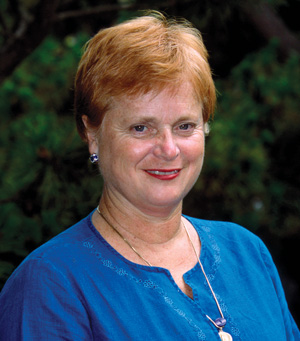From Mind to Market: Paula Brock
Mimicking nature's best ideas

A bullet train engine shaped like a bird’s beak. Solar cells inspired by leaves. Electronic displays based on butterfly wings. Notice a trend? Copy nature’s best ideas to solve human problems—and in a sustainable way.
That’s the concept behind the emerging field of biomimicry, an approach already embraced by research and industry giants, including GE, NASA, Hewlett-Packard and, closer to home, QUALCOMM Inc.
Enthusiasts argue that nature’s exhaustive catalog of evolution-tested examples contains environmentally friendly answers for every design and engineering challenge on earth, enough to transform industry and save the planet.
At San Diego State, an interdisciplinary group of life scientists, engineers and educators is partnering with the San Diego Zoo to explore that potential. Conservator of one of the world’s largest plant and animal collections, the Zoo offers almost unlimited natural inspiration to designers, engineers and others stumped for design directions.
“Nature is our biggest and best R&D library, with 3.8 billion years of evolutionary research,” said Paula Brock, CFO of the Zoo and a board member of the SDSU Research Foundation. “As stewards of the plants and animals, we want to make our extensive knowledge of them available to inspire sustainable solutions for the thorniest problems.”
The Zoo has also teamed up with the Biomimicry Guild, a Montana-based think tank headed by biomimicry guru Janine Benyus, to develop education and services, such as special brainstorming tours for researchers in both the public and private sectors.
But in order to secure public buy-in for biomimicry research and development, the process must be commercially viable.
“Thousands of new products will result from our collaboration with San Diego State and other universities,” Brock said. “In the area of intellectual property, it’s a treasure trove waiting to be discovered, and we want the SDSU Tech Transfer office in on the ground floor, finding ways to market the discoveries that academic researchers will certainly make.”
At the other end of the spectrum, biomimicry also holds promise as a teaching model to rouse enthusiasm for math and science in young children.
SDSU biology professor Kathy Williams, Ph.D., co-director of the Center for Teaching and Learning, foresees collaboration among Zoo educators and SDSU faculty leading to biomimicry-centered curricula.
“We’re trying to bring this way of thinking about problems and solutions into our classrooms,” she said. “It can be a tool through which students learn by applying their knowledge to real-world phenomena.”



